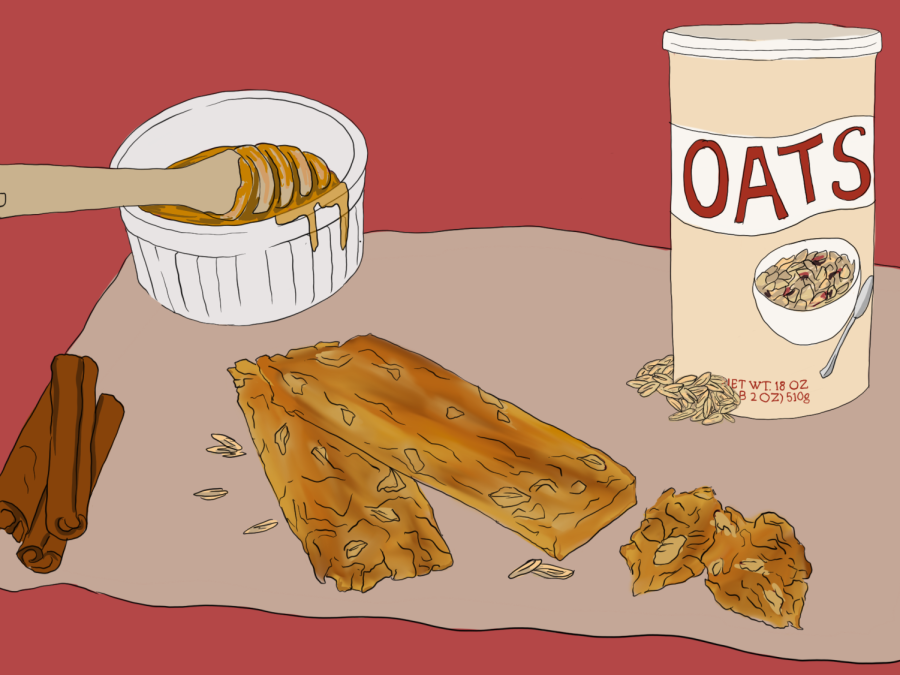Remaking the protein bar: the ugly, processed truth of a beloved snack
With high sugar contents and questionable nutritional values, it can be hard to find a protein bar that delivers on health. Luckily, we remade the bar for the average college student. Recipe included.
Protein bars are a popular snack choice. But they may not be as nutritious as they claim. (Staff Illustration by Aaliya Luthra)
February 9, 2022
With hundreds of pages to read and discussion posts to write — not to mention the commotion of going to and from campus now that classes are in person — sometimes it feels like we are just too busy to stop and eat. If you are anything like me and you’re looking for something quick and convenient that will keep you satisfied until dinner, chances are that you will pick up a protein bar. A bar wrapped in a bright, colorful package, adorned with a label that screams, “21 grams of protein, low fat and zero grams of sugar.”
21 grams of protein. A pretty decent amount for such a compact bar with no sugar. Sounds like a deal — one that’s too good to be true.
That’s because it is.
“Protein bars are candy bars in disguise,” former NYU food studies professor and author Marion Nestle told WSN.
Despite their lofty nutritional claims, many brands contain high amounts of added sugar or sweeteners, such as high-fructose corn syrup, which can increase the risk of chronic diseases like Type 2 diabetes. Companies like Quest that boast that their bars contain only one gram of sugar rely on sugar alcohols (sorbitol, erythritol or other polyols) to flavor their products, which can lead to digestive issues.
Even putting aside the added sweeteners, there is no guarantee that the protein in a bar is high quality. There is no certainty that protein bars deliver high-quality protein, the whole point of the snack.
Again, if you’re anything like me, you’re feeling a little perturbed right now, because your world has been rocked. This picture is not easy to see, but allow me to clear it up for you.
Protein is an essential nutrient that our bodies utilize to repair and facilitate muscle growth. It makes up our hair and nails, and completes other bodily processes that allow us to live. In order to function properly, the protein needs to contain nine essential amino acids. These are referred to as complete proteins and are commonly found in animal proteins like meat and dairy, as well as some plant-based sources such as quinoa and soy.
Not all protein bars contain complete sources of protein. Many derive their nutrients from dairy products such as whey or casein, or plants like soy. While these nutrients come from complete protein sources, they typically contain toxic by-products, making it difficult for our bodies to properly absorb and utilize them.
It’s unclear why protein bars with harmful ingredients are allowed on the market. One possible reason could be a severe lack of federal oversight over production processes.
Unlike other food products such as meat, protein bars aren’t heavily regulated by the Food and Drug Administration. This enables some brands to falsely advertise their products.
“Products marketed as supplements use different labeling — ‘Supplement Facts,’ not ‘Nutrition Facts’ — and nobody pays much attention to whether they have what they say they have or do what they claim,” according to Marion Nestle. “Nobody can confidently trust anything with a ‘Supplement Facts’ label.”
Under the Dietary Supplement Health and Education Act, companies are prohibited from making false claims about the nutritional value of dietary supplements like protein bars. However, according to Nestle, this act further eroded regulatory authority. Because of it, federal regulatory agencies “can’t do much about supplements unless something grossly egregious happens,” she said.
“Something grossly egregious” has happened. In 2015, multiple people filed a filed a lawsuit against protein powder and bar company MusclePharm, claiming that the company misrepresented the amount of protein in their products. However, the court could not resolve the issue since there were disputes about whether the case should be tried at the state or federal level. The issue remains an ongoing debate, but one aspect remains clear: existing federal regulations may not protect consumers from misleading claims.
Despite this lawsuit and others, lawmakers have yet to reform the Dietary Supplement Health and Education Act — reform that Nestle says she thinks is crucial.
“Personally, I think DSHEA is long overdue for repeal but the supplement industry would not agree with this view,” Nestle said.
Not all protein bars are created equal, and not every bar is the same. Some bars, like Outright Bars and Super Pop Snacks Butter Chocolate, offer whole ingredients. Their actual protein contents accurately match the descriptions listed on their labels. Nestle points out, however that real food — that isn’t highly processed — will always provide the highest quality of protein.
“I don’t recommend specific foods, for or against,” Nestle said. “Eat the ones you like [and] enjoy your dinner.”
Well, dinner isn’t for a few hours and I’m thinking of ordering a poke bowl with spicy tuna. Until then, I need something to tie me over.
While protein bars may not contain the best quality of nutrients, there’s something about their convenience and portability — not to mention the sweet yet nutty flavors — that keep reeling me back.
However, all nostalgia aside, I can probably make a better and less expensive bar. So I did.
Given Nestle’s advice, I decided to use primarily whole ingredients and to stray away from any protein powders, so these are oat bars, not protein bars. And even though oats may not contain as much protein as other foods, they are still high in fiber and have plenty of vitamins and minerals.
The recipe below is inspired by the versions made by cooking blogs Jars of Lemons and Cookie and Kate. I adapted them to fit the average college student’s pantry. That being said, feel free to use this recipe as an outline. Don’t let it define your bars, and feel free to add whatever spices, nuts, seeds or other ingredients of your choice. You know your palette best.
Crumbly College Oat Bars: Unstable like your life, yet utterly convenient and satisfying
Prep time: 15 minutes
Refrigeration time: One hour
Difficulty level: Easy
Ingredients
• 2 cups of oats, ungrounded or grounded
• ½ cup to ¾ cup of peanut butter, the runny kind with only peanuts and salt
• Honey (use maple syrup or agave as a vegan alternative)
• Ground flax seeds
• Optional, but highly recommended: cinnamon, chocolate chunks, dried fruit, nuts or seeds.
Procedure
Line a baking tray with parchment paper or tin foil.
Combine the peanut butter and honey into one bowl and set aside. These are your wet ingredients.
In a large bowl, combine the cinnamon, oats and flax seeds. These are your dry ingredients.
Using a spoon or your hands, mix the wet and dry ingredients until combined. Add additional honey or peanut butter if the mixture is too crumbly.
Place the mixture onto a lined baking sheet, then refrigerate for at least an hour.
Enjoy with yogurt or on its own.
Contact Gabby Lozano at [email protected].

























































































































































